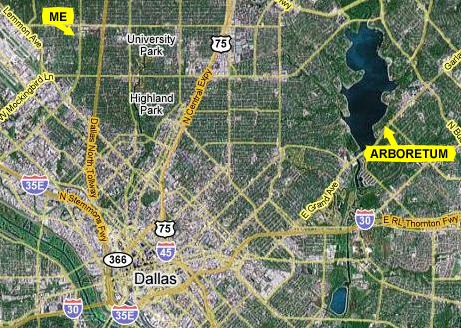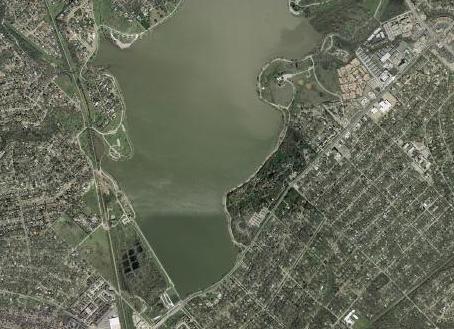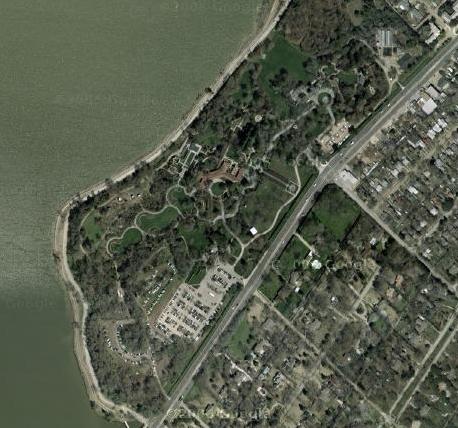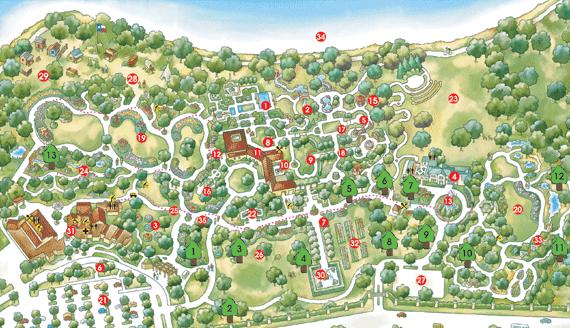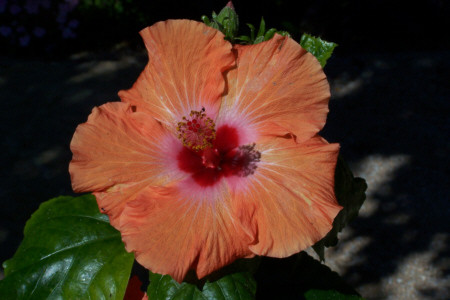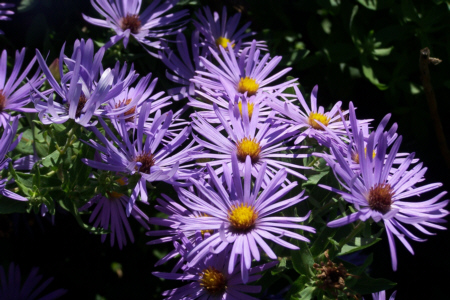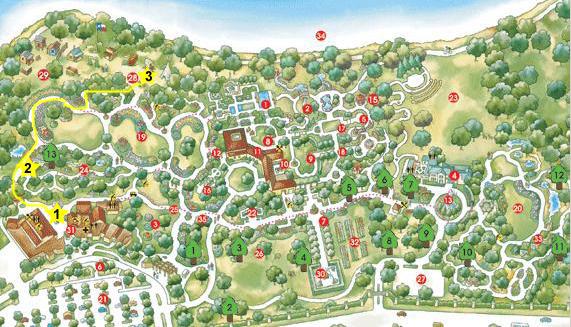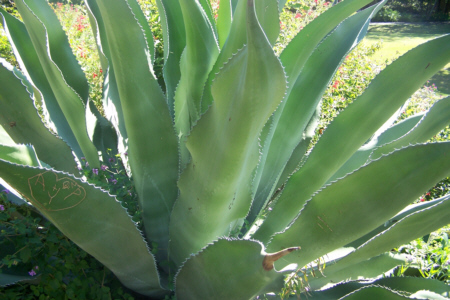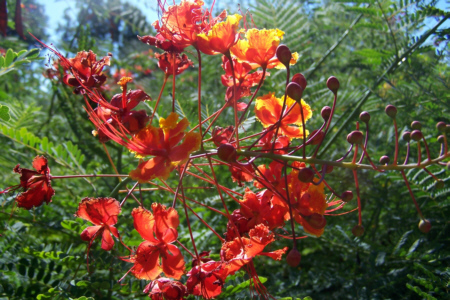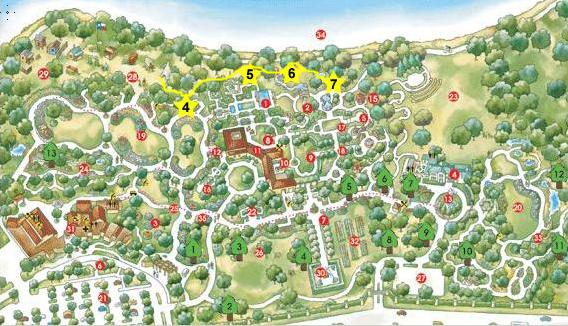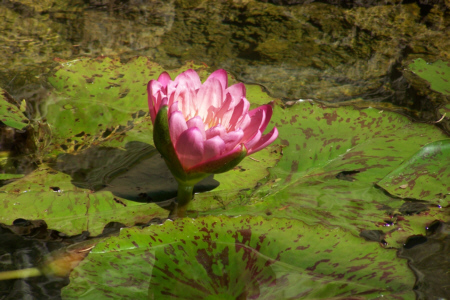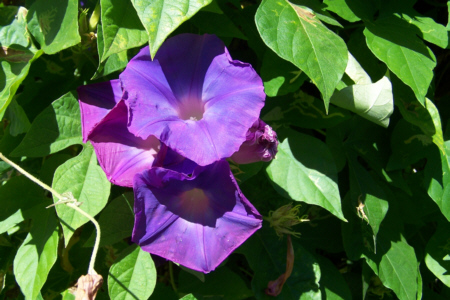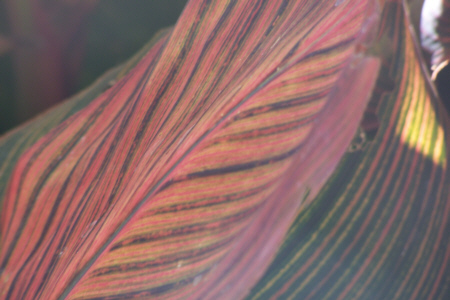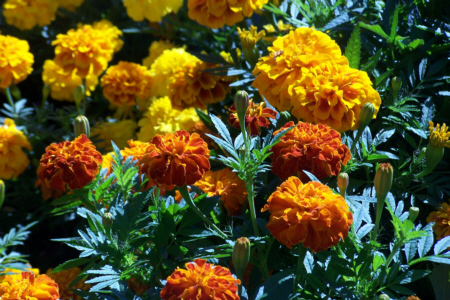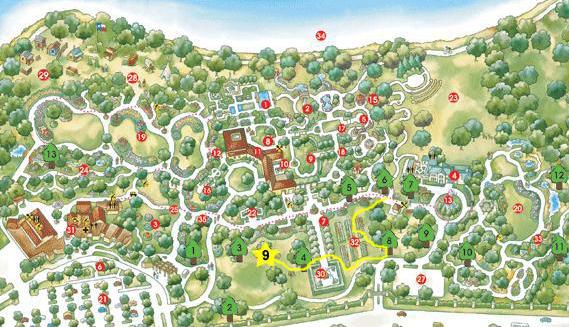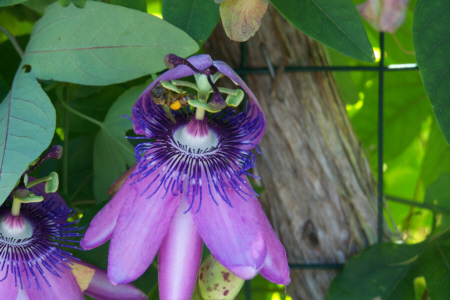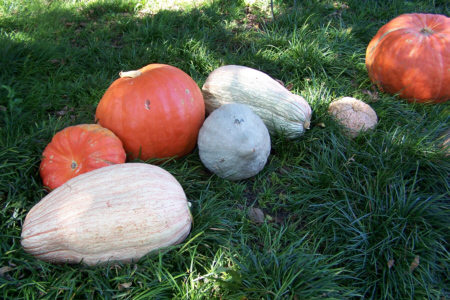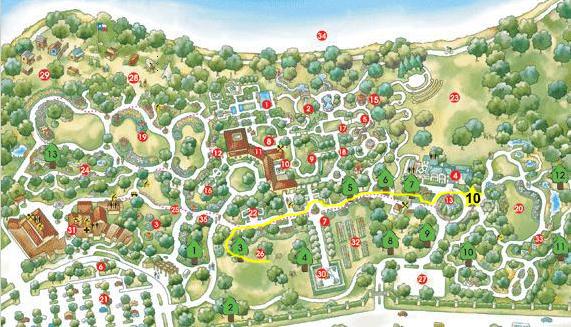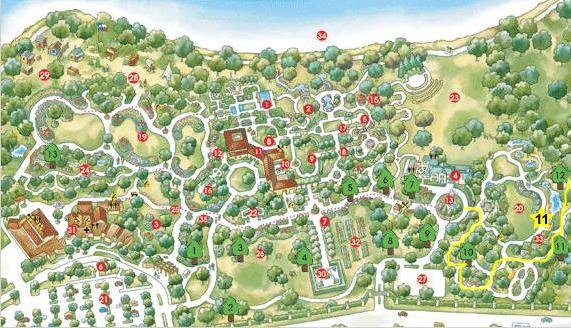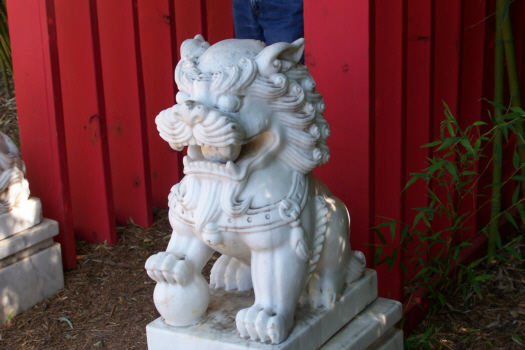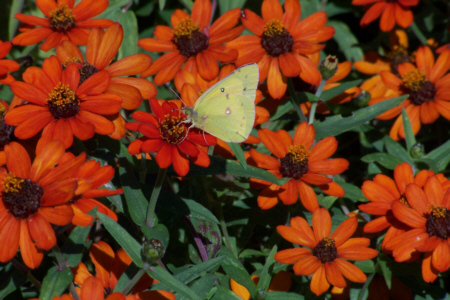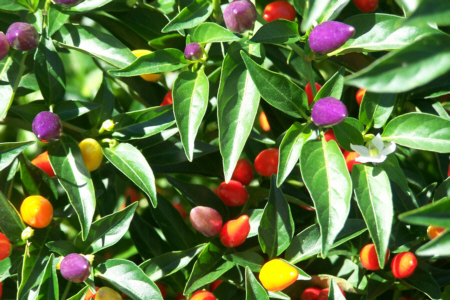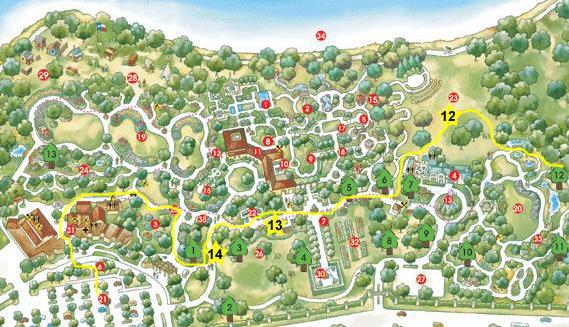 |
November 4, 2006: A Day at Six Flags |
 |
October 8, 2006: Greg's New Dallas Condo |
 |
Return to Index for 2006 |
October 21, 2006
A Trip to the Arboretum
Today was a beautiful day, actually quite warm for October, and so we decided to head over to the Dallas Arboretum to see the Fall displays. The theme for Fall was "The Ultimate Treehouse," and there were a number of fanciful treehouses (not actually built up in the trees, but down on the ground where you could walk through them) throughout the Arboretum, some of which you'll see pictures of here.
The Dallas Arboretum is not too far from where I live over on Inwood- I'd guess about six or seven miles as the crow flies (see the map opposite)- but you can't get there as the crow flies because White Rock Lake is in the way. So you can either go through town and wind your way around the south end of the lake or you can take Mockingbird over around the north side of the lake. Which way you go depends on traffic, but, since we were coming from the Bentley Manor today, we just came down Lemmon and went through town.
White Rock Lake is where one of the long bike trails is, and we have biked around it numerous times.
In this closer view, you can see the south end of White Rock Lake and you can pick out the bike trail that hugs the lake shore almost all the way around. At the south end is White Rock Lake Dam and spillway, which takes the overflow water and sends it under Garland Road to continue on down to the Trinity River.
The bike path used to cross the top of the dam, but for one reason or another, the bike path was rerouted a year ago, and now it goes through some parkland and playing fields south of the dam, across the spillway, up Garland Road for a ways, and then back north along the lake shore.
You can also see a closer view of the Arboretum in this picture, and can begin to pick out some of the pathways through the gardens.
Finally, in this close-up of the Arboretum itself, you can see most of the major features- including the parking area just off Garland Road, the new administrative buildings, the restaurant and gift shop (all right near the parking lot) and, off in the middle of the gardens, the DeGolyer house (the former residence of the family that donated the land for the Arboretum to the Arboretum Society.
You can also see the maze of pathways that criss-cross the gardens.
I don't suppose it's particularly important that you know exactly where we were in the Arboretum when each picture was taken, but I have obtained a current map of the Arboretum (see below), and I will occasionally indicate by a yellow star on the map where certain features were located. This way, you can get an idea of the layout of the gardens and have an appreciation for just how far you can wander around. Membership in the Arboretum has been one of the best investments we've made, for it is always a joy to go there.
Fred enjoys very much taking pictures of various flora in the gardens. Sometimes, he wants to record what something is, so he'll take a picture of the sign and the flower or plant. Other times, it's just the beauty of the specimen that catches his eye. I would like for you to see some of these pictures, so I will sprinkle them through this particular page. I won't try to label each of them; just enjoy their beauty. (If you want to know what they are, you can ask the expert.)
Exploring the Arboretum
>
After parking and entering through the Member's Entrance, we were in the administration area, where the offices, gift shop, restaurant and some other buildings are (#1 on the map). Here, there are lots of potted and in-ground plants, kind of an introduction to what you will see in the gardens at that particular season. One of the potted plants had a small visitor, and Fred took
his picture.
There are an infinite number of routes through the gardens, of course, so we just picked one and started off. Our route took us down by the end of the plaza where the restaurant is, and then down into the gardens towards the fern grotto. Here, there is a bridge where the artificial stream that runs through the shady fern area (#2) goes over a
small waterfall
and then under the walkway. In the summer, the ferns and other plants suited to shady, moist areas are lush, and there are misters that keep them looking that way.
We continued up around the walkway that in the spring is rife with azaleas and stopped at "Texas Town." This area has some replicas of frontier Texas buildings and such and is designed to give kids something to do (since the presumption is that they don't get nearly the pleasure out of looking at the flora as their parents do). We wandered around the cabins and such for a while, and stopped at this
indian teepee.
Fred was attracted to the teepee by the
buffalo paintings
on the outside of it. Inside, there were some simulated Indian artifacts and utensils, as well as a real
buffalo hide
hanging on a drying rack.
Leaving Texas Town, we walked back towards the center of the gardens to the walkway that is bordered by azaleas in the spring (#4). Today, the Arboretum has put out Fall color, which in this area of the gardens means
mums.
One of the newer additions to the Arboretum is the Woman's Garden (named for the organization that spearheaded the fund drive that resulted in its construction, and not for some supposed relationship between women and certain plants). It is a sunken garden, just below the reflecting pool (#5), and so is a secluded area with benches and such for relaxation. Today, though, we are following an even newer path between the Woman's Garden and White Rock Lake. Here is a view of some of the
sailboats on White Rock Lake
taken from this vantage point; it was pretty windy and the folks out on these rented boats seemed to be having a lot of fun. In this new area of the Arboretum (which is not yet fully landscaped) they have put in a whole series of new water features, such as this authentic-looking
stone cistern
that sits at the end of an artificial stream.
Just a short ways further on through this as-yet incomplete area, we found yet another new water feature. This one brings water from an area near the reflecting pool, through a very nicely-done stone-bordered channel, down a
step waterfall
and into a small,
ledged pool
where the pump that carries the water back to the top of the channel is located. All very nicely-done, and it will look even better when the plants are in and the landscaping is done- although I doubt that you'll be able to get up on the water feature once that's done. But for now, we could walk up on the channel and follow it back to
its source
at the completed walkway near the Woman's Garden (all this at #6 on the map).
Now we are in the general vicinity of #7 on the map, just east of the Woman's Garden. This area is also relatively new, but the landscaping is much further along and there are a lot of visitors wandering around. This is another new water feature, a beautiful
lily pool
with a walled waterfall behind it. This is actually the source of the small stream that leads down to the new, unlandscaped area we just came from. This is undoubtedly the most beautiful water feature in the Arboretum, and a lot of work has gone into it. Perhaps the movie that I made of it will give you a better appreciation for just how nice it is. Use the player below to watch it.
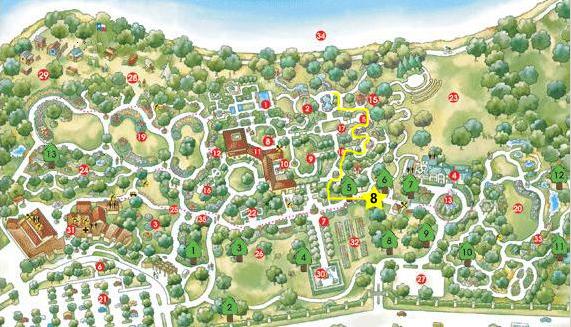 |
Each year, the Arboretum does something unique involving displays throughout the gardens. In one memorable past year, giant insects were created out of wood, and they were placed unobtrusively so that guests in the Arboretum could seek them out. This year is no exception. Early this year, the Arboretum put out a call for designers to submit ideas for a display of treehouses- although the treehouses would not actually be perched in the trees but rather would "use" the existing trees in their designs. The Arboretum wanted guests to be able to interact with the designs, each of which was to express a particular theme. In late summer, the thirteen winners of the competition built their designs in the Arboretum so that they were ready for the Fall display.
We had not known about these displays until we came to the gardens, nor did we know how many displays there were. At our next stop, #8 in the map opposite, we encountered the first three of these treehouse interpretations. I have found pictures and descriptions of all thirteen of the designs on the Internet, and I will insert each of them here- including the ones we did not find.
How else would you expect a beautiful specimen tree to grow but in a 10 foot pot watered by a 12 foot metal watering can. From a distance, these objects are so familiar and in scale we have to move closer to examine our discovery of a tree house and the fun it offers. What would it feel like to stand up next to a tree and feel like the size of an ant? Using scale and perception, an ordinary tree can become a place to stretch one’s imagination. The Potted Tree re-creates the ordinary objects required with maintaining a potted plant and allows both children and adults to experience these ordinary objects in a rare way that becomes extraordinary. Looking at the design from afar, the tree is scaled down to the size of a potted plant. The size of the pot and the watering can are proportional to the size of the tree. This makes the pot 10 feet tall and the watering can 12 feet tall. Changing scales transforms the tree into a fantasy place that attracts the curious.
We walked up into the center of the Arboretum from the water features in the new section of the Woman's Garden, and found the first of the treehouse designs- the Potted Tree (treehouse #5 on the Arboretum map above). You can see
Fred in front of the potted tree,
with the tree seeming to grow out of the pot (which you could go inside). Next, there's
me with the giant watering can
and finally Fred with the
Potted Tree Treehouse.
A giant butterfly might intellectually be implausible but its grace and thematic content makes this tree house design seem like a visual requirement for any self-respecting garden. FlutterBy is an interactive experience that incorporates nature and design. The garden is a delicate arrangement of vibrant annual color which attract the butterfly. A pathway through allows for individual exploration. The large floating wings above provide shade to the structure below. The form celebrates the metamorphosis from caterpillar to cocoon into the fluttering by of the butterfly.
The next treehouse interpretation was just a few feet away- FlutterBy (treehouse #6 on the Arboretum map above). This was a fanciful butterfly with wooden wings and a floor, so you could enter the treehouse and walk through it. We took two pictures here-
me with FlutterBy
and
Fred with FlutterBy.
From FlutterBy, we walked over towards the test gardens (marked on the map above as red number 32). Fred always likes to look through the various plants that the Arboretum is evaluating for inclusion in the gardens, and he is usually able to get some cuttings of new plants that he hasn't seen before. While here, I found an interesting view. The Arboretum had planted a stand of lavender-colored lantana, and it was doing well. What was interesting was not the lantana itself, but the
apparent interloper-
or maybe it was just a bloom that just wanted to be different. Also in the test gardens was one of the
largest‑leaved plants
I'd ever seen- something related to an elephant ear, I'd guess.
|
The Underground Treehouse |
This tree house has a roof top deck mirroring the ground level, and earth walls that eliminate many of our first response sensations to a garden. In return, it creates a keener insight of the world from ground level as we look through a periscope to view a narrow visual strip across the Arboretum to the lake. The Underground Tree House explores the idea of what it feels like to be ten feet underground. From the outside, it appears as a simple cube of Plexiglas with wood cladding. The roof top garden serves as the only hint that something out of the ordinary is happening. Upon entering the cube, a completely different story is told. Roots flourish above your head, a dirt wall anchors the structure and whets your appetite for the next engaging experience. Another wall, filled with educational marvels, demands your attention and captures your imagination. Take a look through the periscope and view what ants and other insects would see if they were meandering through the above rooftop garden. As you exit the Underground Tree House, you can’t help but want to explore it again.
And the next treehouse interpretation- The Underground Treehouse- was right next to the test gardens (treehouse #8, near the test gardens, on the Arboretum Map above). When we walked through it, I wasn't quite sure what it was supposed to be. It seemed just like a wooden box, but there were three periscopes that showed you the view on the "roof" of the treehouse, and the roof was planted to mimic the grounds of the Arboretum. So I guess you might think you were, in fact, underground.
From the Underground Treehouse, we headed back across the test gardens and past the frog fountains (red number 30 on the map at right), and over towards the pumpkin patch. On the way, we passed yet another treehouse.
This open structure appears very exposed and public, and yet it is a good example of the similarity to ascending a platform in a tree house to find a very personal and private space. Accentuating this sensation is a series of periscopes that, in this case, go high into the branches. These multi-color periscopes ascend the tree for you. Replacing a conventional rope ladder, stucco blocks climatically draw passer-bys into the tree house. A beauty that is only present in natural surroundings encourages onlookers to pause. Beneath the weathered aluminum canopy, restless souls find nourishment. Yet, the open construction invites recreation. Once inside, playfully hued periscopes rouse the imagination, magically elevating one high into the branches. These portholes provide a revitalizing escape to the outside world. Views from this fresh perspective reawaken a hidden peace. However, this transposition is not a mere diversion sought in blind naivety. Rather, the same colorful steel tubes descend from the tree’s canopy, morphing into supporting trunks and anchoring roots. It is here, engaged in the dialogue between fantasy and reality, that we are able to obtain a portrait of completeness.
This particular treehouse (treehouse #4 on the Arboretum map) looked like something modernistic from the 1960s, and
here
you can see some of the visitors to the Trans-Position treehouse.
Another attraction that you can find at the Arboretum each October is the Pumpkin Patch. They bring in a huge number of pumpkins of all sizes (including a lot of gourds and other pumpkin-like things) and people enjoy taking pictures of family and friends with the pumpkins as background. This year, though, the pickings were kind of sparse, as the pumpkin crop, at least around here, has been much smaller than in years past. I've read that there has been some sort of virus or decay that has taken a lot of the pumpkins before they could ripen. So there weren't nearly as many this year as there usually are.
But the people at the Arboretum are nothing if not inventive. One amazing thing they did was to build a huge pumpkin-shaped framework and actually plant live orange zinnias so that the end result looked like
a giant pumpkin,
with a circle of pumpkins around the base for good measure. Also, out in the walkway, they constructed a beautiful arrangement of
pumpkins, mums and peppers.
Ultimate Blooms tree house (treehouse #3 on the Arboretum map) is a series of tulips that might remind a person of their favorite organic hiding place. The widely spaced slats do not conceal someone completely, but enough that a passerby distracted by the hustle and bustle of the world would not discover them. Someone, while hidden and camouflaged by the petals of flowers, leaves of a tree, or other organic material, is free to peer at the world around them without judgment. The design allows the patron to directly participate in the actions of a butterfly or similar insect as they become the “Pollinator” and move within the three tulip blooms. This concept creates both a visual and educational experience. The tulips are connected by a wheelchair accessible ramp and elevated pathways, as well as steps to provide movement between the blooms, simulating pollination. Bolted, plywood ribs stand 11 feet tall and represent “nectar guides” radiating from the tulip center which will draw “Pollinators” to the flowers. The plywood ribs are in-filled with painted wood slats just as visual cues such as color in flowers attract certain “Pollinators”. The slats are also angled specifically to create and control the visitors’ view from within the tulips.
Continuing on past the Pumpkin Patch, we came to the Ultimate Blooms treehouse. It was constructed out of a series of interconnected wooden "tulip blooms," like the one you can see
here
with Fred. There were quite a few kids playing around in them, and I had to wait a while before I could get a picture without them.
From the Ultimate Blooms, we headed back towards the back of the Arboretum, following the main walkway towards the entrance to the Rose Garden, Lily Pond and Waterfalls (yellow star #10 on the map). Alongside the main walk was a very nice arrangement of
ornamental peppers, mums and palms
with begonias, mondo grass and a background hedge. A bit further along, back near the Potted Tree treehouse, we found some unusual black (actually dark purple) elephant ears, and you can see Fred posed in front of them
here.
The materials, structure and theme of this tree house subordinate it to the gardens. Basket woven bamboo around the tree reflecting the shape of the sprouting tree limbs provide us with a tree house accentuating the tree and reminding us of a known garden object. The dense and solid exterior really serves as a transparent bris soleis when you enter this tree house filled with light. The design of this tree house is inspired by primitive basket weaving. The choice of bamboo as the primary material was influenced by my childhood memories of the Camp Estate being surrounded by a dense bamboo thicket. Before the arboretum was created, this thicket attracted millions of blackbirds each evening to roost. The weathering of the organic material from green to straw color during the six month installation will signal the transition of seasons. The rope used is nylon and will retain its bright color for the duration of the exhibition. The basket will be kept open within its interior to create an interesting experience looking up and around the trunk of the tree. The steel superstructure is a “tensegrity frame”. In other words, it acts as a self supporting element much like a basket or lamp. The basket is designed to conform to the general shape of the tree. The top is shaped in response to the limbs and overall form of the tree.
As we walked down the center path, we encountered another treehouse that we had missed earlier. Here I am, standing in the doorway of
The Bamboo Basket,
treehouse #7 on the Arboretum map above. Then it was across in front of the Alex Camp House (the only other structure on the property that eventually became the Arboretum) and into the back part of the gardens.
This area of the gardens (marked by yellow star #11 on the map) is always a pleasure to walk around in. Near the marker are some waterfalls that actually form walls of water that are part of a larger structure that has plants and vines hanging down from an overhead trellis. Nearby, there are interconnect coi ponds with a profusion of lily pads and a number of small, brass animals sprinked about- armadillos, squirrels, rabbits and the occasional
snake.
Square of Circles is a magnificent tree house erupting out of the forest. How you get in or out is only solved by a leap of faith. A push on one of the yellow pipes reveals they are hinged, allowing ingress and egress. Again there is a transparency between the outside and inside, but once inside you feel protected. This tree-room is an interactive sculpture defined by four walls of yellow pipe and a natural ceiling of branches & leaves. Each yellow pipe projects upward until it encounters a branch, so that each one is a different height. The pipes are hinged on a pivot so that visitors may push them aside and walk between them. The form and shadows are designed to move with the breeze and evolve throughout the seasons. Dedicated to Mom.
The first treehouse we encountered here in the back part of the Arboretum was the Square of Circles (treehouse #10 on the Arboretum map above). Coming up on the treehouse conception from down the path, the contrast of the yellow PVC and the greenery gave the
treehouse
an ethereal, almost fairy-tale-like quality. It's actually a little less impressive when you can see the
entire treehouse.
The frame is free-standing and the PVC are attached only at one point on the frame, so they can swing from side to side allowing you to enter. You might notice how the lengths of the yellow PVC have been adjusted so as not to interfere with any of the branches of the tree as they go out in different directions. Once inside the treehouse, you do feel enclosed and protected, although it's easy to stick your head through the PVC- they easily swing aside. I wanted Fred to take a picture of
me sticking my head out
from an angle down the line of PVC- and it would have been a more interesting shot had not a little girl decided to enter the treehouse just at the moment Fred snapped the picture.
CORE provides us with a window looking in on a moment during its relatively slow life. Its vertical walls, inspired by the nature of the light passing through the bamboo, cut a path providing access to a hideout within the tree’s shade. CORE was created through the manipulation of light, scale, density, and the filtering effect of its surrounding environment. These walls provide a separated yet transparent place which visitors may sit and enjoy the age, texture, and presence of the tree.
Back around by the Rose Garden, there is a stand of bamboo at the very back of the Arboretum. Nestled in that bamboo was another treehouse interpretation- this one called "CORE." The
entrance
to the treehouse was "guarded" by a pair of Chinese-looking dragons, and the fact that the treehouse was constructed entirely of bamboo and painted red (the lucky color in Chinese lore) all lent a consistency to the theme. When you walk down the "hall" behind Fred, you find yourself in a red bamboo cage, with a tree growing up through the middle and some benches built into the walls of the cage. It is hard to describe, so maybe the movie I made of it will do it more justice. You can use the movie player below to watch it.
Frame Work reminds me of the work of the late great modernist Bud Oglesby. Whether it’s a townhouse or a mansion, Oglesby always designed his houses around a framework running the length of the house, opening to a beautiful view of water, bluffs, gardens or trees. Here you have your views framed without the distraction of single purpose rooms nearby. The project is a sculptural and interactive piece, incorporating a linear site line between the tree and the adjacent limestone terrace that consists of several water features. The “viewing concept” is experienced through a series of picture windows that facilitate the idea of duplicity of views between the tree and the terrace. The built structure includes a covered sitting area, as well as sculptural elements and features that are created to be enjoyed by children and adults alike.
Walking further around the back of the Arboretum, past all the bamboo, brings you to the farthest point you can get to from the entrance to the gardens. And here was yet another treehouse. This one (called "Frame Work" and noted on the Arboretum map above as treehouse #12), is a modernistic ramp and ledge system all built around a large tree. You can see a picture of Fred standing at the top of the entrance ramp with the waterfall rooms in the background
here.
NOTE:
The next two movies are Fred's, and you can watch them with the two players below.
From the Frame Work treehouse, we walked over towards White Rock Lake where there is an amphitheatre (yellow star #12 on the map at left). We had heard music playing, and we wanted to see what was going on. There were a few people sitting on the grass listening or picnicking, and there were a few couples just lying in the warm sunlight. You can view the movie that Fred took of the performer and the surroundings using the left-hand player below.
We started walking back to the entrance to the Arboretum, again along the main pathway, looking at the plant and floral displays as we went. A ways along the pathway, we came upon a squirrel (a live one, this time) who was jumping around and carrying stuff so quickly that we thought he might have inside knowledge that the next day would bring snow! Fred decided to take a movie of the squirrel's antics but, as so often happens, he seemed to get stage fright once he realized he was being filmed. Have a look using the right-hand player below.
Climbing trees make a person increasingly aware of smaller and smaller details of its structure as the limbs become smaller and the leaves become more abundant. The leaf structure of this tree house allows you to imagine if you are ascending to the smallest edges of a tree where you stop and make your home. By day, this green structure totally blends in with the background. At night, illuminated with white light, it glows. Beyond the typical four walls, floor and ceiling, a tree house is the adventure, the experience, a child’s escape from an adult’s structured world. The concept of “tree house” often evokes thoughts, memories, history, and imagery of childhood and parenthood: activities and learning, the act of construction and personalization, nature and our relationship to it. But, traditional form and materials often confine the limitless imagination. The leaves of the tree provided the basic form for our design. Through the use of parametric 3-D modeling software, the basic “leaf” surface was generated, and transformed into the “wall panels” that create the tree house. Precision in fabricating the components, as well as being able to accurately quantify the construction materials, makes these very organic, expressive forms, feasible to assemble and install. To represent the personalization of the tree house, area school children crafted their own “leaves” to be hung inside the house. The leaves draw the eye upward and engage you with wind, sound and sky.
Back towards the entrance, we found het another treehouse- Leaves Imagination (noted as treehouse #1 near yellow star #14 on the map above). This was probably the most fanciful treehouse we'd encountered so far, with its graceful, arching
mesh and fabric leaves.
Three Treehouses We Didn't Visit
In our meanderings through the Arboretum, there were three treehouses that we didn't visit, but I wanted to show you pictures and give you descriptions of each of them. I've added to the description the location on the map above where the treehouse was located.
Arbor-Tropism reminds us that people and nature seek out trees to find shelter, to lean against, or just to sit under. This structure points to and embraces the tree from a slight distance, the distance we often gravitate to a tree. Organic structures representing an attraction to nature form a protective embrace around the tree. No physical contact is made, yet feelings of aspiration, tension and Henge-like revelry abound. This design was born from the basic ideals that drive any sanctuary of nature – the primal attraction of people towards their natural environment. Organic forms forged out of both natural and manmade elements coexisting in harmony.
(This treehouse, #9 on the Arboretum map above, just escaped our attention, even though it was located near another one we stopped at.)
A 220 year old bois d’arc tree with sprawling, sprouting branches and gnarly texture full of permutations and imperfections deserves to be a tree-house. A red nylon fabric used for athletic equipment bags is stretched on a frame to create an entrance and the personal space of the tree. Entering this space, you are forced to look toward the tree as you circle it – awed by its age, character, history and strength (bois d’arc is used for foundation piers as termites cannot even penetrate it). When you look away you look through the red nylon mesh as if you are seeing the Arboretum through rose colored glasses. The French have a word for “so ugly it is beautiful,” jazz musicians compliment “a dirty voice,” applauding its character, not clearness. An arborist should coin a word for a tree ravaged and yet resistant to time, strong, but nearly forgotten. Shelter and house have been synonymous to most of us since our earliest memories. In the world of imagination for both young and young at heart, a tree has many times been a house. Many have sought the cool shade of a tree on a hot summer day and sometimes sought its shelter from the harsh wind. Surprised by a spring shower, we have huddled near its trunk to shelter us from the rain. Artificial elements have been used to define space and complement the natural definition of volume already created by the tree branches and leaves. These artificial planes join the natural play of transparencies set up by the branches and leaves. The tree’s branches also set up natural entry points and barriers. The colorful planes accentuate this naturally occurring order. Natural, artificial, ephemeral, permanent, translucent, opaque, protective and revealing all complementing and contrasting each other to reveal a unique experiential perspective for the visitor. Is the tree the house or is the house the tree? In the end, the answer to this question is not as important as is our experience of the “Tree-House”.
(This treehouse, #2 on the Arboretum map above, was way off by Garland Road at the edge of the Arboretum- in an area we rarely visit.)
Casa Musgo is the house most organically intertwined with the tree. While man-made, the planned structure, natural environment, and planted flowers all blend inside and outside of this tree house. Casa Musgo (Moss House), is inspired by nature itself. From the outside one sees a rush of color from the perennials and the jewels that adorn the windows and rooftop. Your attention is next drawn to the ivy that trails upward and intertwines as it reaches for spider plants that drop from the upper edge of the walls. Finally your focus is captured by the cooper roof that over time will patina to the earthy color of the walls around it. Since this house is created with nature in mind, it does not distract from, but rather adds to the natural beauty of the tree.
(This treehouse, #13 on the Arboretum map above, was actually the first one we might have visited had we known where they all were. But I am just now aware of all of them, and we are sorry to have missed it.)
Our Arboretum Visit Ends
>
We finally worked our way back to the entrance to the Arboretum. At the entrance the staff puts some of the nicest Fall color, since they know that not all their members or visitors are capable of wandering through the entire garden, and we have taken some pictures of these color beds for you to see. First, Fred captured an excellent picture of the garden mums in one of the arced flower beds. This view looks back towards the interior of the Arboretum, and you can see his picture
here.
I took a similar picture of the colorful beds of garden mums, but my view looks towards the entrance to the Arboretum- the plaza where we began the afternoon. You can see this picture
here.
To finish off the photographic record of our Fall visit to the Dallas Arboretum, I asked Fred to pose for a picture here at the color garden, again looking back towards the interior of the gardens. You can see that picture
here.
Postscript: The Spoils of War
Being the professional that he is, Fred doesn't just wander about places like the Arboretum without using his critical eye and his knowledge to identify new varieties of plants or new colors of old favorites. When he finds something new, he has no compunction about committing a misdemeanor and carefully taking a cutting so that he can propagate the plant either at Crumps Garden or at his own home greenhouse. Actually, I am sure that taking unauthorized cuttings is not nearly a misdeameanor, but just moderately against the private rules of the Arboretum.
But what did he get today? Enough to fill my biggest bowl at home:
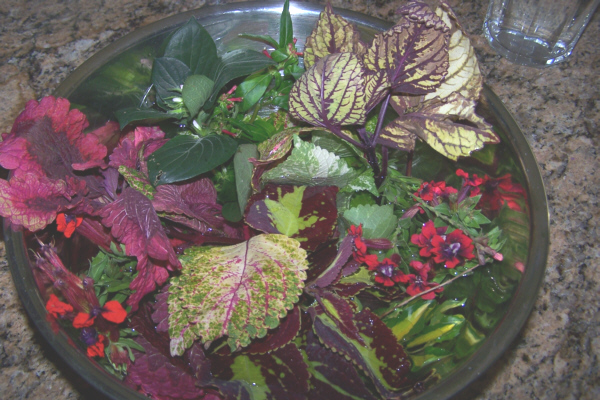
Thanks for visiting the Dallas Arboretum with us!
You can use the links below to continue to another photo album page.
 |
November 4, 2006: A Day at Six Flags |
 |
October 8, 2006: Greg's New Dallas Condo |
 |
Return to Index for 2006 |






